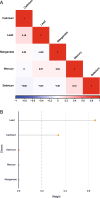Serum 25-hydroxyvitamin D mediates the association between heavy metal exposure and cardiovascular disease
- PMID: 38383352
- PMCID: PMC10882793
- DOI: 10.1186/s12889-024-18058-z
Serum 25-hydroxyvitamin D mediates the association between heavy metal exposure and cardiovascular disease
Abstract
Background: Mediation analysis aims to determine how intermediate variables affect exposure to disease. In this study, 25-hydroxyvitamin D (25(OH)D) was evaluated to assess its role in mediating heavy metal exposure and cardiovascular disease (CVD).
Methods: A total of 9,377 participants from the National Health and Nutrition Examination Survey (NHANES) for the years 2011-2018 were included. Firstly, restricted cubic spline (RCS), and multivariable logistic regression model were performed to estimate the association between heavy metal exposure (Cadmium, Lead, Mercury, Manganese, and Selenium), as well as serum 25(OH)D and CVD. Secondly, using generalized linear regression model and generalized additive models with smooth functions, we investigated the correlation between heavy metal exposure and serum 25(OH)D. Finally, the mediation effect of serum 25(OH)D in the associations between heavy metal exposure and CVD was explored.
Results: The RCS plots revealed that Cadmium, and Lead were positively and linearly associated with CVD, while Mercury, and Manganese were inversely and linearly associated with CVD. Additionally, a roughly L- and U-shaped relationship existed between Selenium, as well as 25(OH)D and CVD. When potential confounding factors were adjusted for, serum 25(OH)D had negative associations with Cadmium, Lead, and Manganese, while serum 25(OH)D had positive relationship with Selenium. There was a mediation effect between Manganese exposure and CVD, which was mediated by 25(OH)D.
Conclusion: According to the mediation analysis, the negative association between Manganese exposure and incident CVD was increased by 25(OH)D. The increasing dietary intake of Vitamin D could increase the protective effect of manganese intake on CVD.
Keywords: Cardiovascular disease; Heavy metals exposure; Mediation analysis; Serum 25-hydroxyvitamin D; United States.
© 2024. The Author(s).
Conflict of interest statement
The authors declare no competing interests.
Figures





Similar articles
-
Association of serum five heavy metals level with all-cause and cause-specific mortality: a large population-based cohort study.J Environ Sci Health A Tox Hazard Subst Environ Eng. 2024;59(3):130-154. doi: 10.1080/10934529.2024.2339776. Epub 2024 Apr 12. J Environ Sci Health A Tox Hazard Subst Environ Eng. 2024. PMID: 38613167
-
Association of blood metals with serum sex hormones in adults: A cross-sectional study.Environ Sci Pollut Res Int. 2023 Jun;30(26):69628-69638. doi: 10.1007/s11356-023-27384-5. Epub 2023 May 4. Environ Sci Pollut Res Int. 2023. PMID: 37140863
-
Association between heavy metal exposures and the prevalence of pelvic inflammatory disease: a cross-sectional study from the National Health and Nutrition Examination Survey 2013-2018.Environ Sci Pollut Res Int. 2023 Nov;30(52):112433-112444. doi: 10.1007/s11356-023-30176-6. Epub 2023 Oct 13. Environ Sci Pollut Res Int. 2023. PMID: 37831240
-
Association of placental weight at birth with maternal whole blood concentration of heavy metals (cadmium, lead, mercury, selenium, and manganese): The Japan Environment and Children's Study (JECS).Environ Int. 2024 Jun;188:108725. doi: 10.1016/j.envint.2024.108725. Epub 2024 May 13. Environ Int. 2024. PMID: 38759546
-
A State-of-the-Science Review on Metal Biomarkers.Curr Environ Health Rep. 2023 Sep;10(3):215-249. doi: 10.1007/s40572-023-00402-x. Epub 2023 Jun 20. Curr Environ Health Rep. 2023. PMID: 37337116 Free PMC article. Review.
Cited by
-
Association Between Urinary Metals and Polycyclic Aromatic Hydrocarbon Levels and Cardiovascular Disease Among Adult Americans: Data from NHANES 2011 to 2016.Cardiovasc Toxicol. 2025 Jul;25(7):929-943. doi: 10.1007/s12012-025-10009-3. Epub 2025 May 27. Cardiovasc Toxicol. 2025. PMID: 40423918
-
Association between blood manganese and cardiovascular diseases among U.S. adult population.Sci Rep. 2024 Dec 28;14(1):31260. doi: 10.1038/s41598-024-82673-4. Sci Rep. 2024. PMID: 39733137 Free PMC article.
-
The association between non-high-density lipoprotein cholesterol to high-density lipoprotein cholesterol ratio and chronic obstructive pulmonary disease: the mediating role of dietary inflammatory index.Front Nutr. 2024 Sep 9;11:1427586. doi: 10.3389/fnut.2024.1427586. eCollection 2024. Front Nutr. 2024. PMID: 39315013 Free PMC article.
-
Association between heavy metals and risk of cardiovascular diseases in US adults with prediabetes from NHANES 2011-2018.BMC Public Health. 2025 Jan 30;25(1):391. doi: 10.1186/s12889-025-21552-7. BMC Public Health. 2025. PMID: 39885432 Free PMC article.
-
Oxidative balance is associated with diabetic kidney disease and mortality in adults with diabetes mellitus: Insights from NHANES database and Mendelian randomization.J Diabetes Investig. 2025 Mar;16(3):451-462. doi: 10.1111/jdi.14390. Epub 2024 Dec 26. J Diabetes Investig. 2025. PMID: 39724381 Free PMC article.
References
-
- Xiao S, Zhou Y, Liu T, Hu Y, Wu Q, Pan Q, et al. The association between manganese exposure with cardiovascular disease in older adults: NHANES 2011–2018. J Environ Sci Health Part A Toxic/Hazard Subst Environ Eng. 2021;56(11):1221–1227. - PubMed
Publication types
MeSH terms
Substances
Grants and funding
LinkOut - more resources
Full Text Sources
Medical

